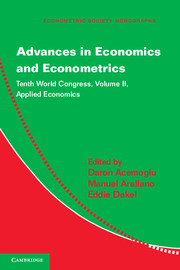Book contents
- Frontmatter
- Contents
- Contributors
- Preface
- I FINANCE
- II POLITICAL ECONOMY
- III MACROECONOMICS
- IV TRADE AND FIRM DYNAMICS
- V GROWTH
- 9 Structural Development Accounting
- 10 Misallocation, Economic Growth, and Input–Output Economics
- VI FRISCH LECTURE
- VII PERSPECTIVES ON CHINESE ECONOMIC GROWTH
- Name Index
- Miscellaneous Endmatter
9 - Structural Development Accounting
Published online by Cambridge University Press: 05 May 2013
- Frontmatter
- Contents
- Contributors
- Preface
- I FINANCE
- II POLITICAL ECONOMY
- III MACROECONOMICS
- IV TRADE AND FIRM DYNAMICS
- V GROWTH
- 9 Structural Development Accounting
- 10 Misallocation, Economic Growth, and Input–Output Economics
- VI FRISCH LECTURE
- VII PERSPECTIVES ON CHINESE ECONOMIC GROWTH
- Name Index
- Miscellaneous Endmatter
Summary
Introduction
New technologies do not diffuse instantaneously, and adoption lags are considered a major determinant of productivity differences across firms and nations. In a classic paper, Griliches (1957) documented that new, more-productive seeds of hybrid corn diffused slowly across U.S. agricultural regions, with a 15-year lag between adoption in Iowa and Alabama, and that their diffusion was affected by local conditions such as geography and market potential. The spread of more recent technologies follows a similar pattern. Kiessling (2009) reported evidence of slow adoption of information and communication-technology diffusion both between and within countries. For instance, although personal computers became available in the early 1980s, in 2006, the percentage of the population using computers was 80.6 percent in the United States, 36.3 percent in Spain, 5.6 percent in China, and 2.7 percent in India. Cross-country studies confirm that technology adoption depends on both country-specific factors and characteristics of new technologies. For example, a McKinsey (2001) report on India identified as a major source of inefficiency the fact that firms are too small to benefit from the best technologies and that these may require skills that the country does not possess. The importance of local economic conditions also was stressed by Caselli and Wilson (2004), who showed that countries import technologies complementing their abundant factors; and by Ciccone and Papaioannou (2009), who found that human capital fosters the adoption of skill-augmenting technologies. At the aggregate level, there is evidence that differences in technology are a key determinant of cross-country income disparities.
- Type
- Chapter
- Information
- Advances in Economics and EconometricsTenth World Congress, pp. 373 - 418Publisher: Cambridge University PressPrint publication year: 2013
- 9
- Cited by



